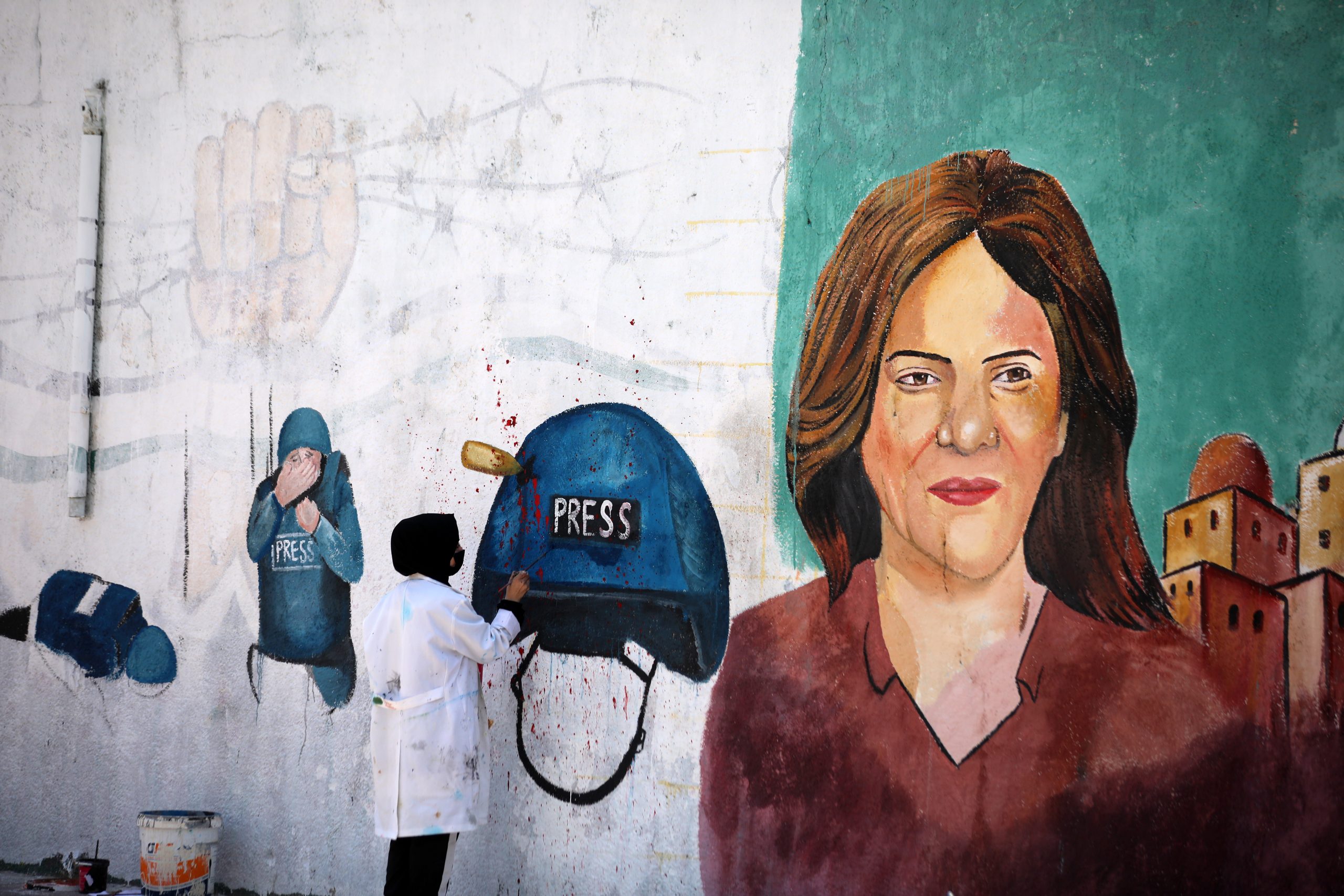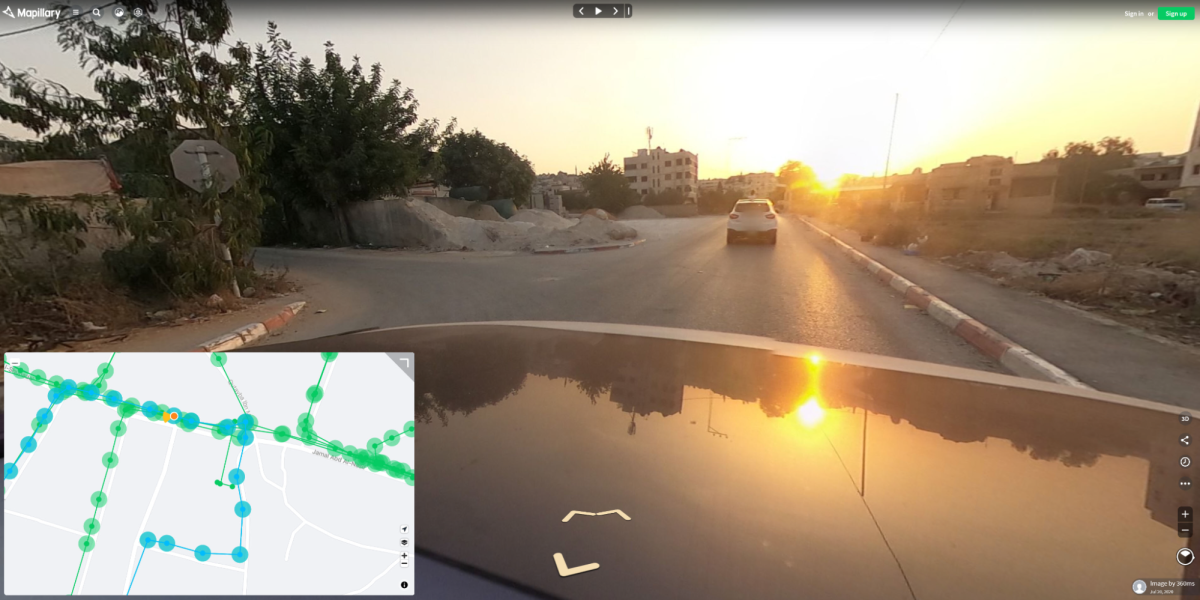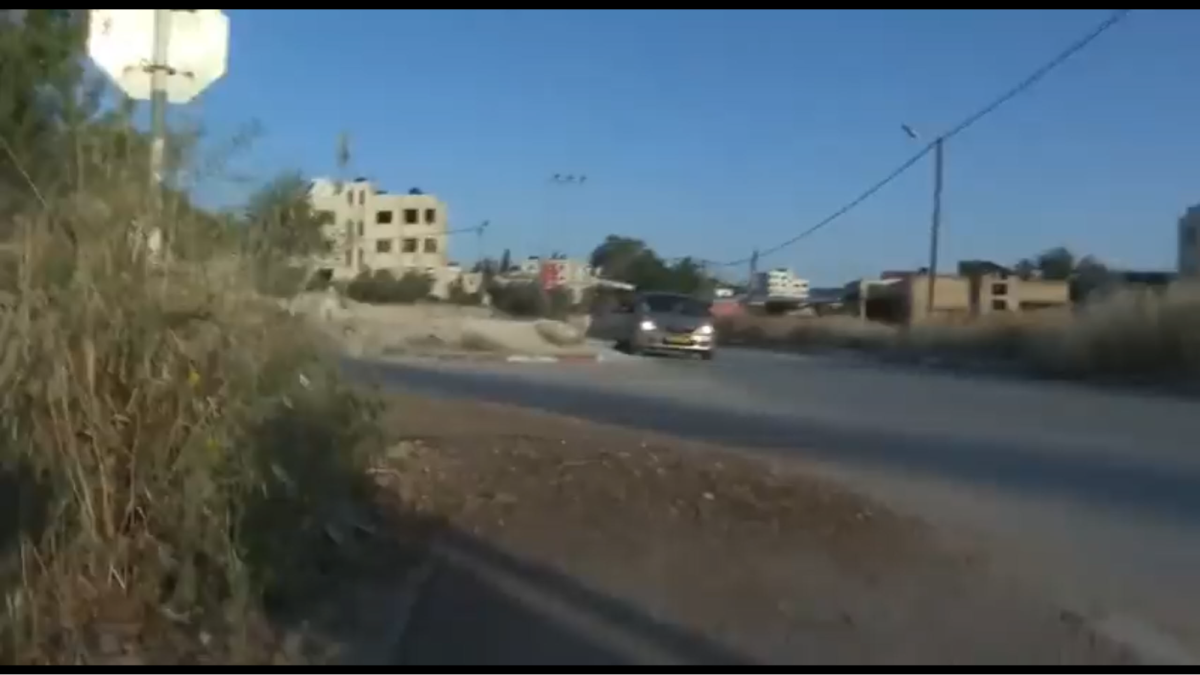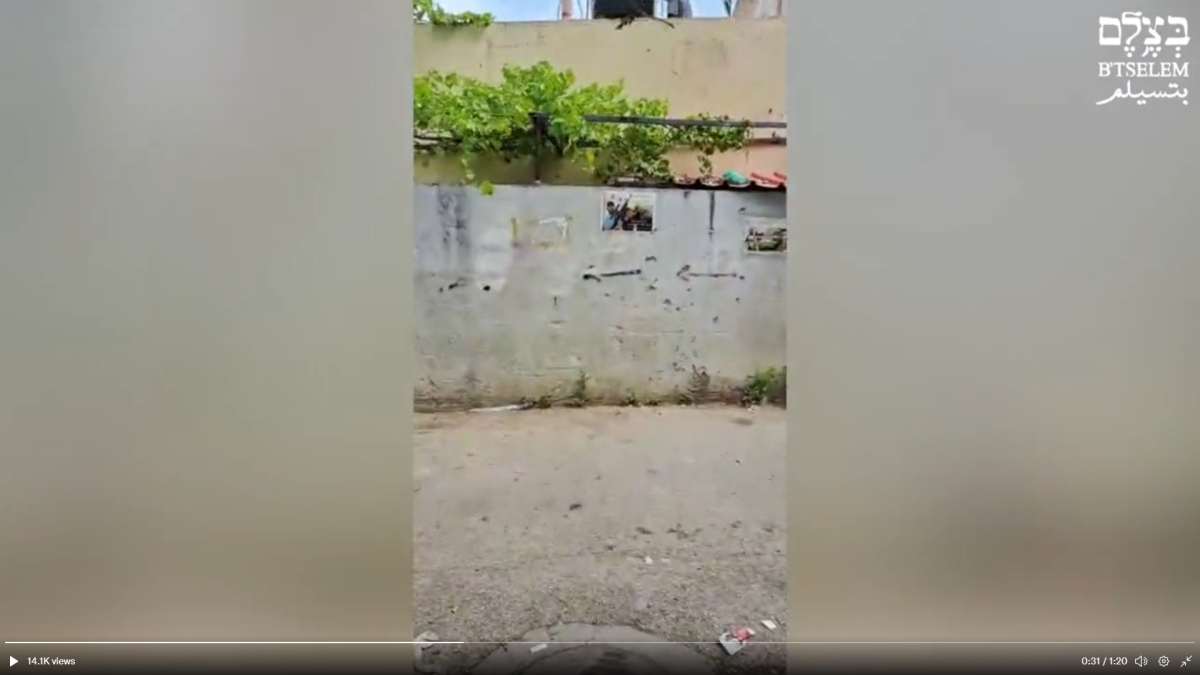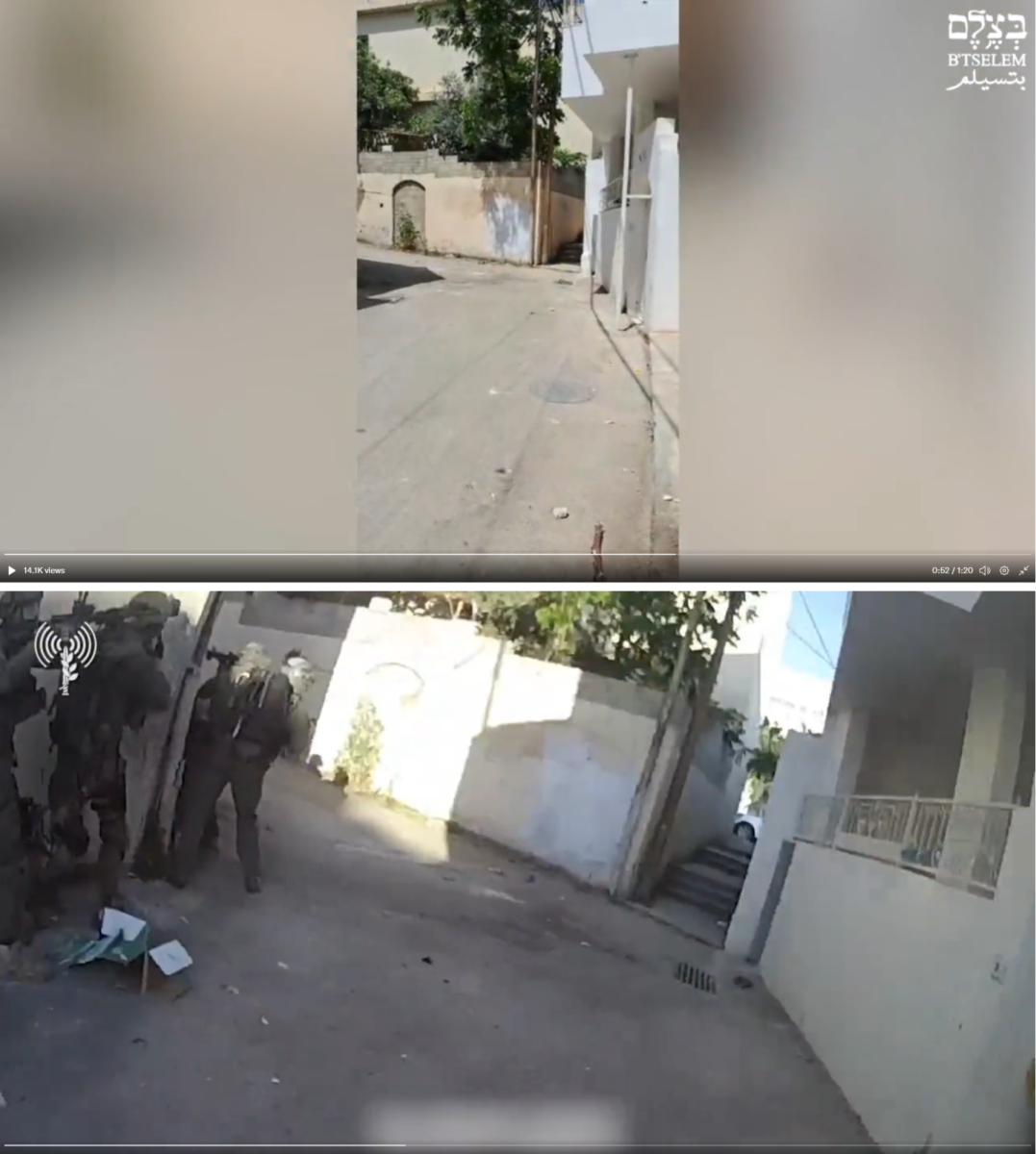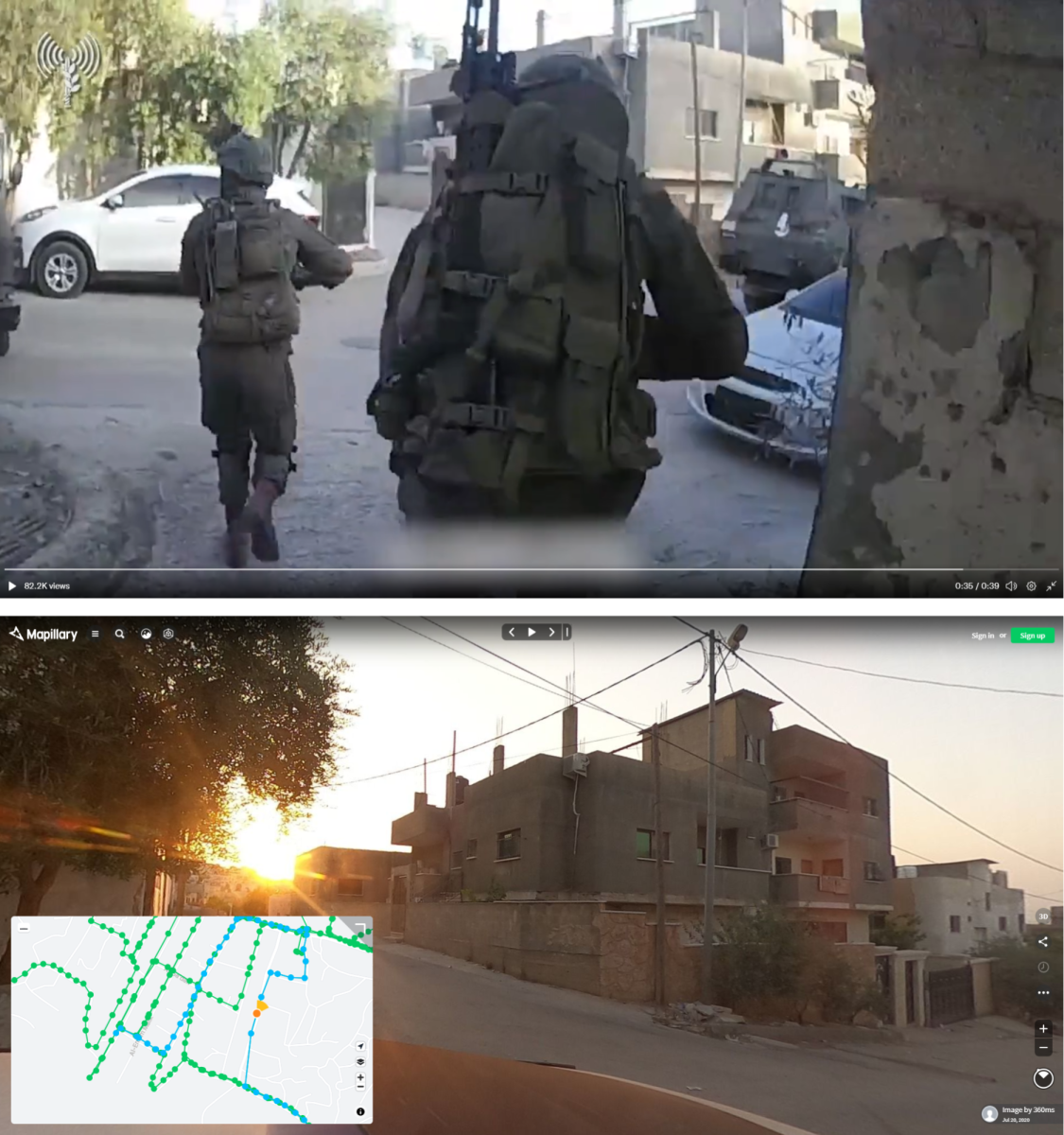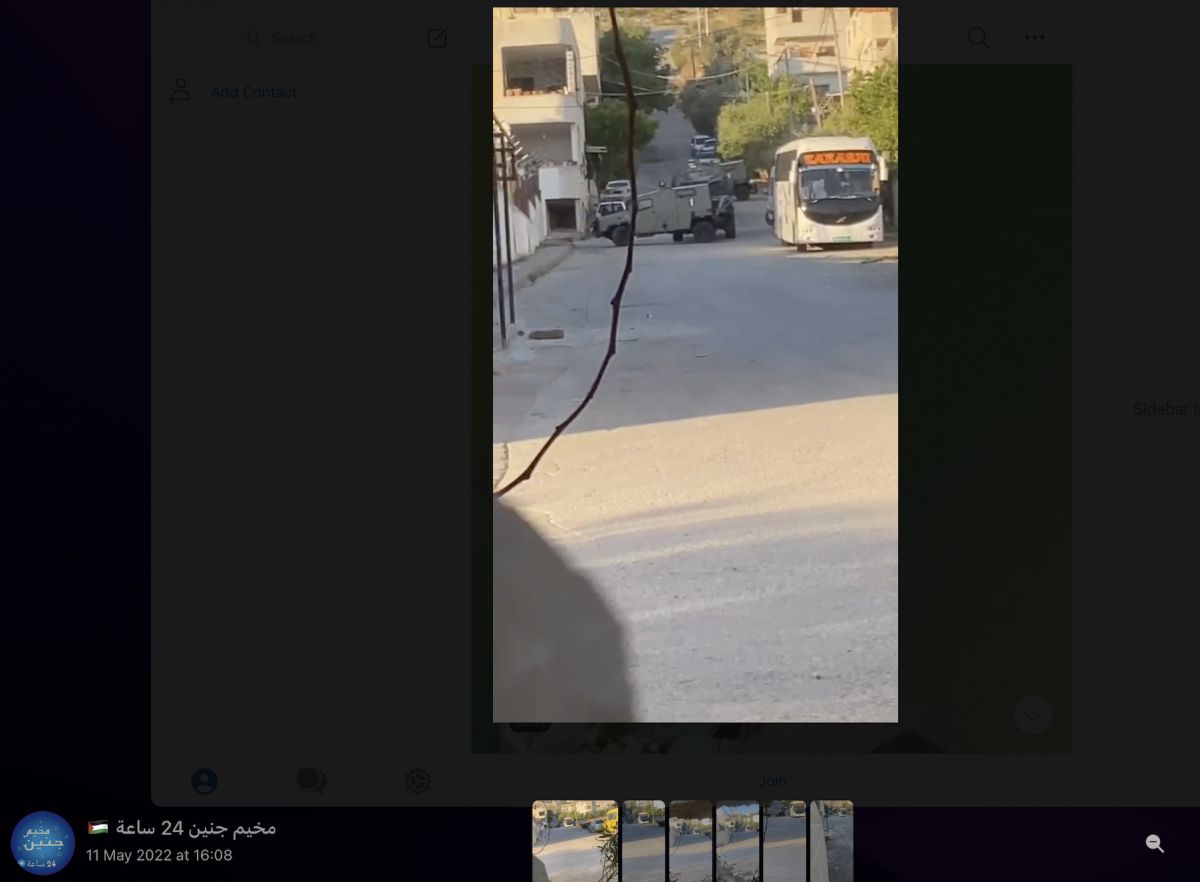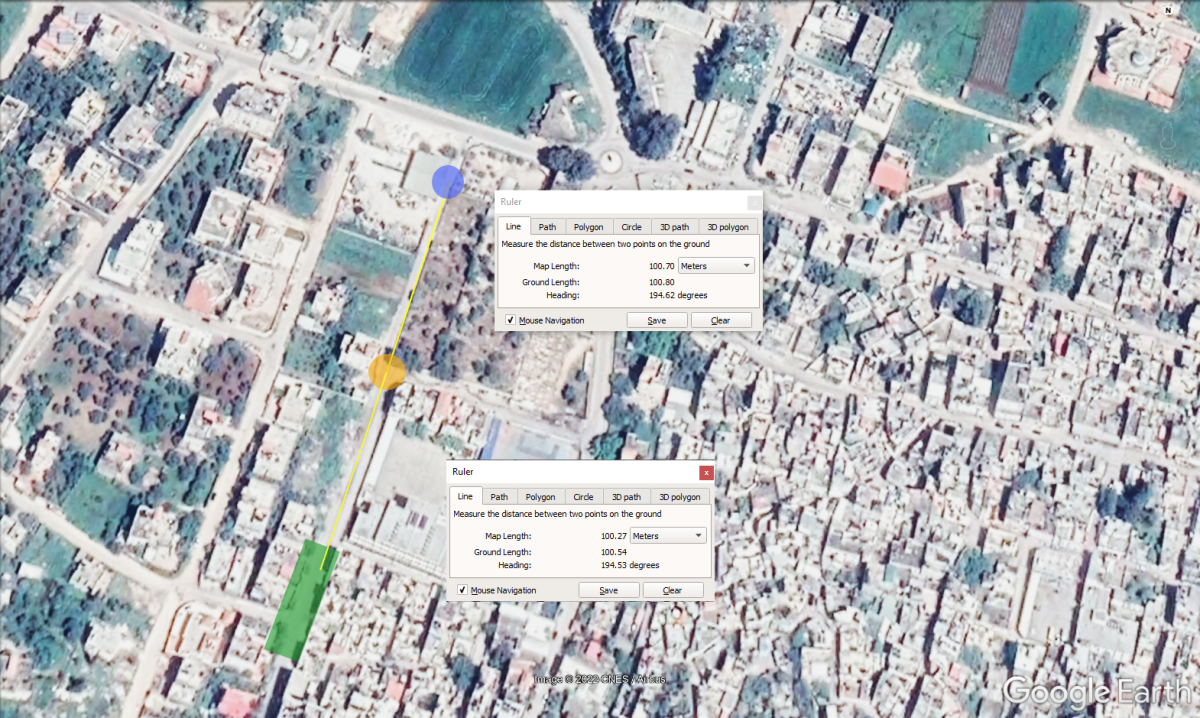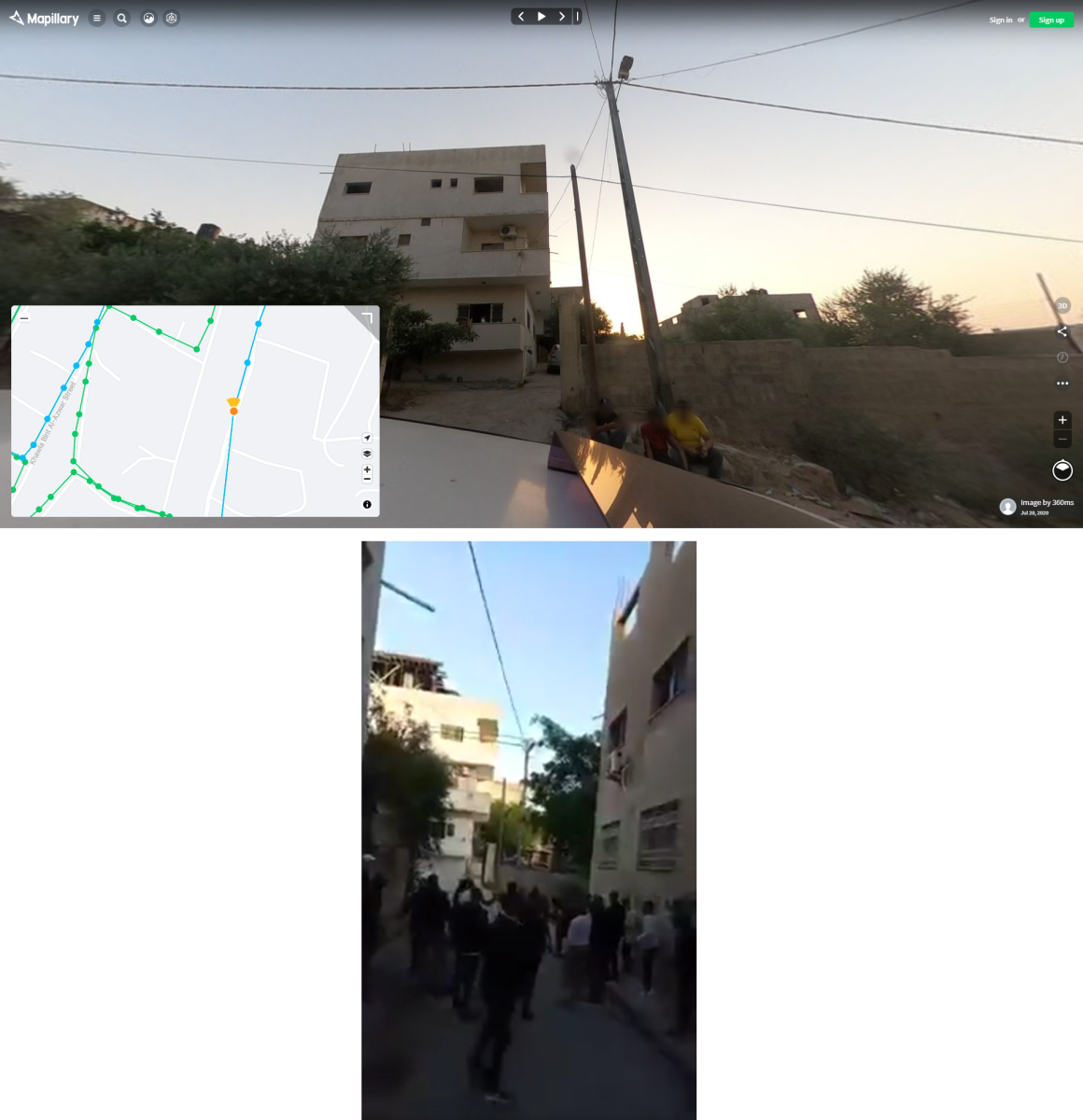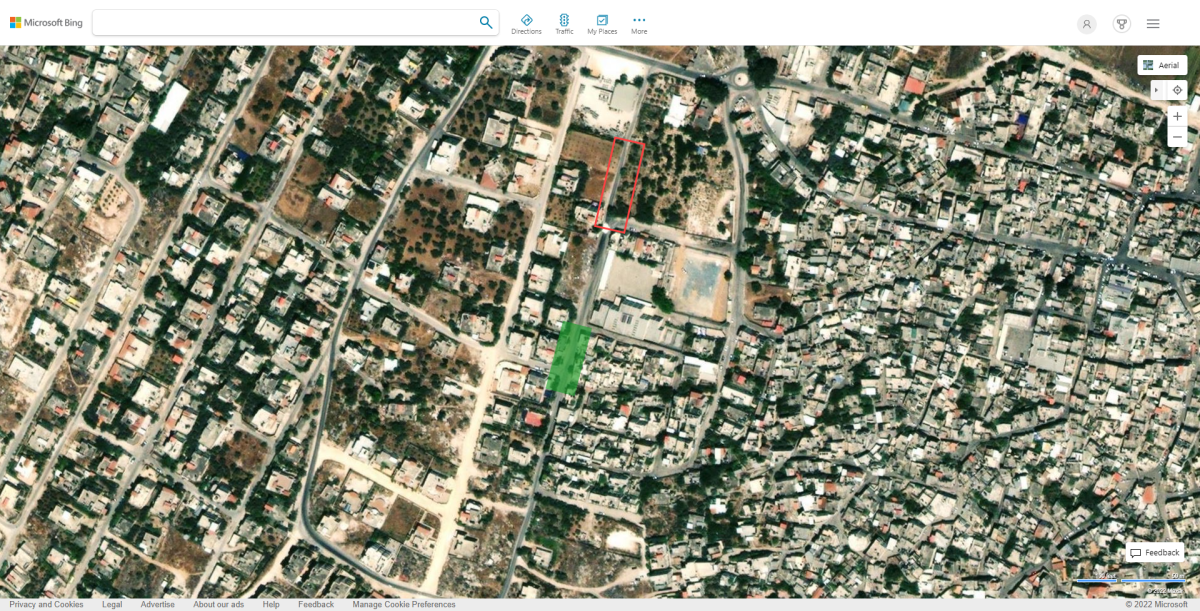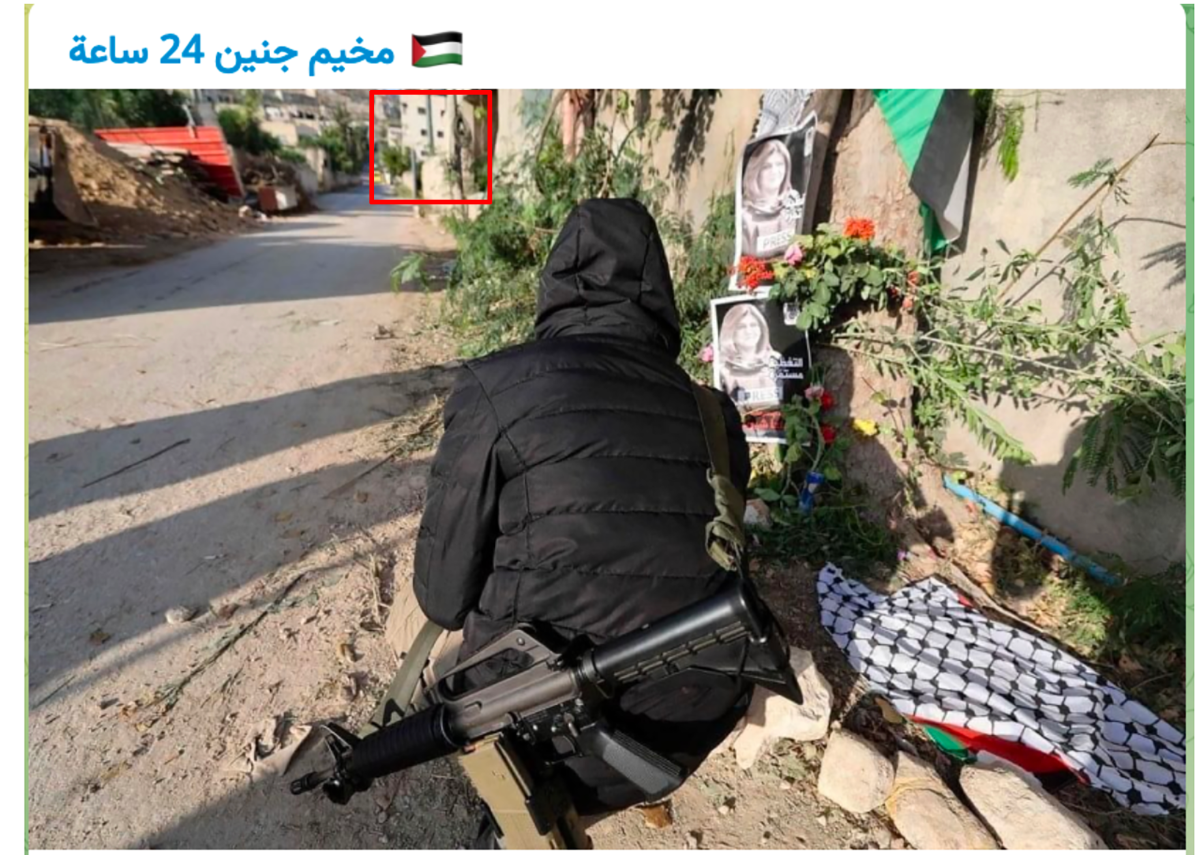Shireen Abu Akleh, a prominent Palestinian-American journalist working with Al Jazeera, was killed by a gunshot to the head on the morning of May 11, 2022 while reporting from Jenin, a Palestinian city in the West Bank. Abu Akleh was covering a raid that was being conducted by the Israeli Defence Forces (IDF). It was one of several raids the Israeli military has conducted in Jenin some of them deadly, amid rising unrest in recent months.
The aftermath of Abu Akleh’s killing was captured on videos that were quickly shared on social media. The footage shows the chaotic moments after the journalist was shot, including attempts by others to reach her body.
This video evidence shows that Abu Akleh suffered a gunshot wound to the head.
As can be seen in the videos, Abu Akleh — along with another reporter who was with her at the scene — was wearing a blue vest clearly labelled “PRESS” as well as a helmet.
A few hours after the journalist was killed, Israel’s Prime Minister Naftali Bennett initially claimed that there was a “considerable chance” that “armed Palestinians, who fired wildly”, were responsible. But in a later press conference, Israel’s Defence Minister Benny Gantz stated: “It can be Palestinians who shot her. Tragically, it may be on our side. We are investigating it”.
Palestinian figures are widely sceptical as to the impartiality of an Israeli inquiry into Abu Akleh’s killing.
The Palestinian Authority, as well as Al Jazeera itself, has squarely blamed the Israeli military, whose initial probe on the day of the shooting stated that it was “inconclusive” whether the journalist had been killed by Israeli or Palestinian gunfire.
Witnesses — including journalists who were with Abu Akleh when she was killed — claim that IDF soldiers opened fire on them without warning, and that they believe that they were deliberately targeted as journalists.
Although the IDF has come to accept the possibility that one of its soldiers may have been responsible, its interim findings, released on May 13, only presented scenarios in which the killing of Abu Akleh was accidental.
While open source photographs and videos alone may not be sufficient to fully establish who fired the shot that killed Abu Akleh, they can begin to build a picture of how events at the scene unfolded and be compared to official statements and testimonies to see if any inconsistencies exist.
For example, the IDF interim report suggested there could have been combatants between the soldiers and Abu Akleh and that an Israeli soldier’s bullet inadvertently hit the journalist. However, there is no video footage of any other armed men in this street between the IDF and the reporters. This version of events would also mean that all of the witnesses and journalists at the scene did not see or neglected to mention the position of any such fighters along the narrow road that separated them from Israeli soldiers.
The same IDF statement also posited that gunmen fired at IDF forces, and could have hit Abu Akleh in the process. Social media video does appear to show gunmen letting off rapid bursts of gunfire from an alleyway, potentially towards IDF troops. Yet the gunshots that can be heard as a man is filmed attempting to retrieve Abu Akleh’s body in the moments after her death are not wild, but slow and deliberate, suggesting targeting rather than a spray of bullets aimed at another object or person. The location of the gunmen depicted in social media videos is also either much further away from Abu Akleh than the IDF troops were, or not in any position to see or target her location.
Other social media images and video, as well as an audio analysis commissioned by Bellingcat, also appear broadly consistent with aspects of witness testimony.
Video footage posted to Facebook just moments after the first reports of Abu Akleh’s death emerged shows IDF forces arriving at a position that stretched approximately 190 to 250 metres south from where she was fatally shot. This is potentially significant as audio analysis of another video posted to Twitter estimates that shots fired towards Abu Akhel’s colleagues as she lay dead originated between 177 to 184 metres away. The same footage also appears to depict gunfire originating to the south as the aforementioned man tries to retrieve her body.
While the Facebook video cannot confirm the exact time of the arrival of IDF troops at the site to the south of where Abu Akleh was shot, metadata from footage filmed by social media users and camera operators at the scene, or from the videos filmed by the IDF, could provide more clarity as to this point. This would also enable a further narrowing down of possibilities as to the position of troops at the time of Abu Akleh’s death.
A Palestinian artist paints a mural in honour of slain Al Jazeera journalist Shireen Abu Akleh in Gaza City on May 12, 2022. Abu Akleh was shot and killed while covering an Israeli raid in the occupied West Bank town of Jenin early Wednesday. Photo (c): Majdi Fathi/NurPhoto via Reuters
Site of the Killing
Multiple videos have been published by eyewitnesses and Abu Akleh’s colleagues showing the aftermath of the shooting in Jenin.
The site of the shooting can be geolocated to a spot on Balat Al Shuhada street in the west of the city. The screen capture below is taken from a video showing the aftermath of the shooting of Abu Akleh, which was shared by an Al Jazeera producer on Twitter. It can be matched to the same location as a 2020 capture from a user of Mapillary, a crowd-sourced resource that collects street-level imagery from dashboard and roof-mounted cameras.
This same location is visible on Mapillary. Note the stop sign on the left and the multi-storey building in the left side of the road in the distance (Source: Mapillary)
Time of the Killing
A series of graphic videos showing the site where Abu Akleh fell contained shadows that allow for an estimate of the time of her killing to be made. The first video showing the scene of the shooting that Bellingcat could find was shared on Telegram at 6:36 AM local time. Ali al-Samoudi, a journalist who was near Abu Akleh when she was shot, also suffered a gunshot injury, and he live streamed his trip to a local hospital starting at 6:33 AM.
The approximate time that this video was captured can be determined by examining the visible shadows. In the aforementioned video shared by the Al Jazeera producer, the camera faces west along Balat Al Shuhada street, before turning southwards towards the body of Abu Akleh. As seen in the video, long shadows of both people and road signs are cast in a west-southwest direction.
By using
SunCalc, a free online tool that calculates the approximate time that a shadow was cast, we can confirm that these videos were indeed captured in the early morning of May 11. It is not wise to determine an
exact time of capture using SunCalc without clear reference points, but by
estimating the height of the object casting a shadow (in this case, people approaching the site of the killing) and direction of the shadows (west-southwest), we can estimate
an approximate time frame of around 6:30 to 7:00 AM local time, which corresponds with the initial reports of the shooting.
Morning Clashes in Jenin
Videos shared on social media that morning show that clashes in the area had begun by 6:00 AM. In one video shared on Telegram at 5:59 AM, recorded approximately 120 metres east of where Abu Akleh would later be killed, gunshots can be heard and a puff of white smoke can be seen rising over buildings in the distance.
In the aftermath of the journalist’s death, some Israeli commentators sought to draw attention to several videos purporting to show armed men shooting at unseen targets in Jenin.
Another video (referred to from now on as “Video Two”) shows a man firing a rifle down an alleyway. Israeli media reports and the IDF have also stated this video was captured on the morning of the raid. The man filmed firing the weapon is part of a group of other armed men who appear to be engaged in a firefight in the area. The Israeli Ministry of Foreign Affairs and Prime Minister initially suggested that Abu Akleh was killed as a result of the shooting in this video. However, analysis of the footage appears to disprove such claims.
B’Tselem, a local NGO supporting human rights in Israel and the Occupied Palestinian Territories, visited the site where Video Two was recorded and filmed a dispatch clearly showing the area. This recording allowed Bellingcat and others to confirm the geolocation of Video Two to an alleyway approximately 270 metres from the site where Abu Akleh was shot and killed.
Furthermore, the B’Tselem video shows that the alley down which the armed man was firing ends with a wall and not the location where Abu Akleh was hit. This means that it is not possible that the individual seen firing in Video Two could have killed Abu Akleh with these shots, despite the social media implications to the contrary.
The fact that Video Two was recorded in the morning of May 11 as the raid on Jenin was taking place is supported by several facts. First, the earliest instance that Bellingcat could find of the video came via Telegram, on May 11 at 6:41 AM. Multiple reverse image searches of frames from this video did not yield any results before this time. Second, B’Tselem travelled to the site where the video was recorded later that morning in response to claims by Israeli politicians and media that the shooter in the video may have been responsible for Abu Akleh’s death. Lastly, the IDF body cam video shows soldiers moving down an parallel alleyway into which the shooter in Video Two was firing his weapon.
This frame from the B’Tselem video shows the end of the alley down which the armed man was filmed firing his rifle. Note the bullet holes on the wall (Source: Twitter)
Bodycam footage published by the IDF later in the day titled “Morning activity by IDF soldiers clearing Jenin” shows soldiers moving through one of the same alleyways shown in the B’Tselem video. A comparison of these two videos indicates that the armed men in Video Two and the IDF soldiers in the bodycam video were located in parallel alleyways. It also appears to suggest that the two groups were engaged in a firefight at around the time that Abu Akleh was killed.
The image comparison above shows a frame from the B’Tselem reference video (top) and one from the IDF bodycam video (below). Note that the IDF soldiers are standing on the same corner by the stairs that was filmed by B’TSelem later in the day. One of the IDF soldiers is aiming his rifle down an alley towards the location of the armed men in Video Two (Source: Twitter)
At the end of the IDF bodycam video, the soldiers run out onto a street where there are five armoured vehicles waiting. This IDF position was located here, south along the same street from the spot where Abu Akleh was shot and killed. The leading vehicle in the convoy was located approximately 190 metres south from the spot where Abu Akleh was shot, while the rear vehicle was located approximately 250 metres away.
Note that the building in the IDF bodycam footage (top) matches the building seen on Mapillary (bottom) approximately 220 metres south on the street from the location where Abu Akleh was shot (Source: Twitter/Mapillary)
A video shared on Facebook and uploaded onto the platform at 6:40 AM shows the same IDF vehicle convoy driving by and coming to a stop at the same location where they are observed in the IDF body camera footage. The upload time places an upper limit on when the IDF soldiers arrived on the scene: in other words, the video must have been recorded prior to 6:40 AM, when it was uploaded onto Facebook.
Because the video appeared to be recorded from inside a home, we will not link to it out of a concern for the safety of the person who recorded it.
The IDF position at the end of the bodycam video was also recorded in a series of six videos by a camera crew approximately 100 metres north, roughly between the IDF position and the spot where Abu Akleh was shot. These videos were posted to Telegram.
IDF soldiers run out onto a street with waiting armoured vehicles as seen in the IDF bodycam video (Source: Twitter).
Journalists north on the same street filmed the IDF operation from their vantage point, approximately 100 metres south of where Abu Akleh was shot (Mapillary). Six videos were shared in total from this location. (Source: Telegram)
In the image above, the blue circle represents the location where Abu Akleh was shot and killed. The orange circle represents the approximate location of the camera crew in the Telegram videos, while the green rectangle represents the location of the IDF armoured column in the bodycam video (Source: Google Earth Pro).
While the IDF body camera footage and the Telegram videos show that the IDF was in control of a section of the street approximately just under 200 metres from the location where Abu Akleh was shot and killed, video evidence appears to show that control of nearby side streets was contested. There is no available footage or imagery that suggests any Palestinian combatants were stationed between the IDF soldiers and Abu Akleh at any stage.
However, a social media video (referred to from now on as “Video Three”) does show a group of men on a street corner nearby. The men appear to be in the midst of a firefight. The video can be geolocated to this location (seen here on Mapillary), approximately one block south of the IDF armoured vehicle convoy.
Multiple shots can be heard being fired in quick succession.
Note that the building and two poles seen on Mapillary (top) are the same as those seen in the background of Video Three (bottom) (Source: Twitter/Mapillary).
Taken together, Video Two, Video Three, and the IDF body cam video allow for an approximation to be made of the positions held by the two parties that were captured on video in Jenin that morning:
The image above shows the spot where Abu Akleh was shot and killed (red circle), and the positions of the parties seen in Video Two, Video Three, and the IDF body camera footage. The green rectangle represents the position of the IDF armoured vehicles; the purple rectangle represents the position of the armed men in Video Two, while the yellow rectangle represents the position of the armed men in Video Three. (Source: Bing Maps).
It was not possible to chronolocate Video Three and define the exact time when it was taken.
However, it is worth noting that in the video that shows Abu Akleh’s colleague coming under fire and posted by an Al Jazeera journalist, the shots seem to be both aimed and deliberate – not wild, undirected sprays. This pattern of gunfire points to the possibility of intentional targeting of the journalists by the shooter, rather than accidental crossfire which would have been the case if Video Three was suggested as a possible source of the gunfire that hit the journalists. The position of the men in Video Three is also significantly further south of the IDF convoy and a greater distance away from the position of Abu Akhel.
What is more, an audio analysis commissioned by Bellingcat suggests that shots fired towards the position of Abu Akhel shortly after her death were from a closer range than where the armed men were positioned in Video Three
Speed and Sound of a Bullet
Bellingcat asked Robert C. Maher, a professor of Electrical & Computer Engineering at Montana State University who conducts research into audio forensic analysis, to look at the social media footage and to try and estimate the distance between the shooter and the person holding the camera near to Abu Akleh in this video, based on weapons seen being used by the IDF and the armed men. In the video clip, Abu Akleh has already been shot, but the group continues to be fired upon from the south.
In an emailed response, Maher wrote that “from the audio recording accompanying the video, there are two audible indications of gunshots at file elapsed time 1:56.25 and at 2:19.538. The two audible reports each consist of a strong initial impulse (‘crack’) sound, followed approximately 300 milliseconds (0.3 seconds) later by a lower amplitude (‘bang’) sound.
“I interpret the initial impulse to be the shock wave from a supersonic bullet (travelling faster than the speed of sound) passing close to the recording microphone, and the following quieter sound to be the sound of the muzzle blast.”
The overwhelming majority of the firearms used in this incident by both the IDF and Palestinian combatants, which were visible in aforementioned videos taken at the scene, appear to be M4 or CAR-15 style 5.56mm rifles, with barrel lengths of around 292 to 368mm. A full comparison of muzzle velocity versus barrel length for 5.56mm rounds of these firearms was published in a presentation of a Swedish expert to the NATO Weapons & Sensors Working Group in 2010.
Using SS109 5.56mm ammunition, a NATO standard round, this would result in a bullet velocity of approximately 820 to 866 metres per second (m/s), indicating a distance of approximately 177 to 184 metres from the rifle to the camera.
Top: M4 rifle, Left; armed man recorded in Jenin, Right: IDF soldier seen on bodycam released by the IDF
Maher added a note of caution and caveats to these calculations.“The estimate of the distance depends upon the air temperature, since this affects the speed of sound,” he said.
While the calibre of bullet analysed is also consistent with reports that the bullet which killed Abu Akleh was 5.56mm, it is also important to note that this calculation does not account for the possibility that another weapon not visible or captured in videos from the scene could have been used.
On top of this, Maher noted that even a slight difference in the assumed speed of the bullet could result in change to the calculations: “Probably the bigger question is my assumption about the bullet’s speed. If the bullet were travelling at a slower supersonic speed, the distance estimate would be longer. If the bullet were travelling at a faster supersonic speed, the distance estimate would be shorter.”
Lines of Sight
Images from the area provide more clues about where the shooter may have been located in relation to Abu Akleh and the other journalists.
An image shared by the Jenin Camp Telegram channel was taken at the spot where Abu Akleh was killed. It is part of a set showing Palestinians placing flowers at the site of her death. The camera faces directly south, allowing us to infer the line of sight towards what would have been the position of the IDF convoy and the armed men.
This image taken from a memorial placed at the spot where Abu Akleh died shows the full length of the road. The lead vehicle in the IDF convoy was located approximately 190 metres away from this spot, near the yellow vehicle in the distance. (Source: Telegram).
The line of sight north from the positions of the IDF vehicle convoy and those of the armed men in Video Two and Video Three were partially obstructed by the perimeter wall of a cemetery. The cemetery and its wall have the effect of reducing the width of the road to a single narrow lane of traffic.
This wall is visible both in satellite imagery as well as in footage from the scene that day.
Note that the cemetery and its perimeter wall (red rectangle) reduce the width of the road significantly, down to a single lane of traffic. The green rectangle represents the location of the IDF convoy (Source: Bing Maps)
The cemetery wall was not the only object obstructing the line of sight north along the road. Throughout the morning, there were vehicles parked on the west side of the road that would have made shooting north from the street-level position of the IDF convoy and those of the armed men in Video Two and Video Three more difficult, although not impossible.
The obstructions in the line of sight caused by the cemetery wall and a yellow vehicle are evident in this image shared on Telegram. The image was taken on a hill south of the road, looking north towards the spot where Abu Akleh was killed.
Note that the line of sight looking north from the road is obstructed not only by the cemetery wall (centre), but also by the white bus and other vehicles parked on the east side of the road. Although it is difficult to tell from the image, the lead vehicle in the image (the one furthest away from the camera) may have had a line of sight to Abu Akleh and the other journalists. The emojis in this image point to the position of the IDF (bottom) and the area where Abu Akleh was shot (top) (Source: Telegram)
As can be seen from the above image, there appears to be a narrow line of sight from the IDF position to the spot where Abu Akleh was shot and killed.
This is potentially significant as the behaviour of the man in the white t-shirt who went to help Abu Akleh (seen in the picture below) suggests that they were still taking fire from the south, as seen in this video. At 01:56 and 02:20, the man breaks cover by moving east, towards the centre of the road, while trying to pick up Abu Akleh. Both times we hear a single shot, clearly close enough to the man to force him back into cover by pressing himself to a wall at the western side of the road. It is possible that the yellow vehicle seen in the image above, and the tree in the image below, would have provided cover when standing closer to the wall.
There also appears to be the possibility that the shooter could have been firing from an elevated position given there is a high-rise building slightly to the west of the IDF position. This would also likely have provided a line of sight to where Abu Akleh and her colleague were situated if they stepped out from behind the tree and away from the wall.
A high-rise building can be seen at the top of the image which captured mourners paying tribute at the scene of Shireen Abu Akleh’s death. Source: Telegram).
This would mean that the man in the white t-shirt would again have been visible to a shooter stationed in an elevated position as he moved out into the middle of the road and away from the wall. However, it must be noted that there is no footage showing any combatant entering into, being positioned in or firing from that building.
The Open Source Summary
While the open source video evidence currently available does not detail the exact moment or shot that killed Abu Akleh, multiple witness testimonies place the blame on IDF soldiers. The available video evidence does not provide good grounds to doubt their accounts — indeed, it appears to support them.
As the open source video evidence shows, when IDF soldiers and an armed group were engaged in fighting on the street where Abu Akleh eventually fell, the IDF position had a clear trajectory and was closer to the spot where she was shot. This is in contrast to the more obstructed and more distant positions of the armed groups. The leading vehicle in the IDF armoured vehicle convoy seen in the bodycam footage was located approximately 190 metres from the spot where Abu Akleh was shot. In contrast, the armed group seen firing down the street in Video Three was located some 300 metres away.
Preliminary forensic audio analysis of a video captured in the aftermath of Abu Akleh’s killing also appears to suggest the gunfire originated roughly 177 to 184 metres away, assuming that the weapon and round used are consistent with those seen being used by the IDF and armed Palestinian groups in the area. This estimate more closely aligns with the approximate distance between the IDF position and the site of the journalist’s killing than between the latter and the location of the armed groups.
Positions of Abu Akleh, IDF and Palestinian militant positions, as well as a range arc showing 177-184 meters (Source: Bing Maps)
On May 13, Shireen Abu Akleh was laid to rest at the Mount Zion Protestant Cemetery in East Jerusalem. She was 51 years old.
Giancarlo Forella served as the primary researcher for Bellingcat, with contributions from Nick Waters and Aric Toler.

